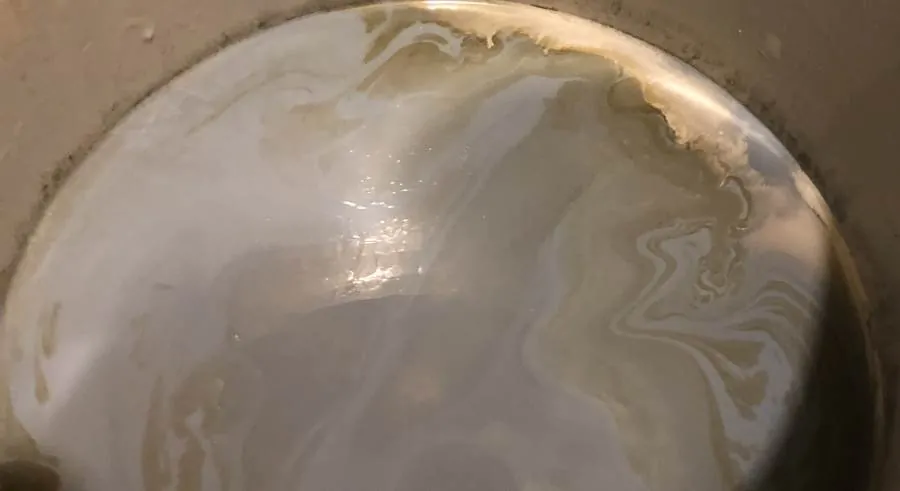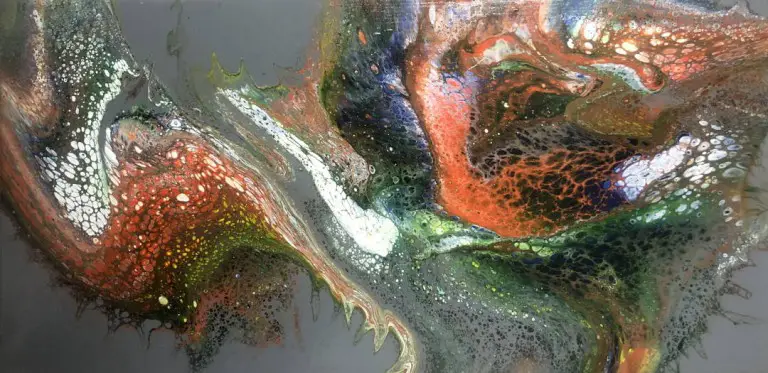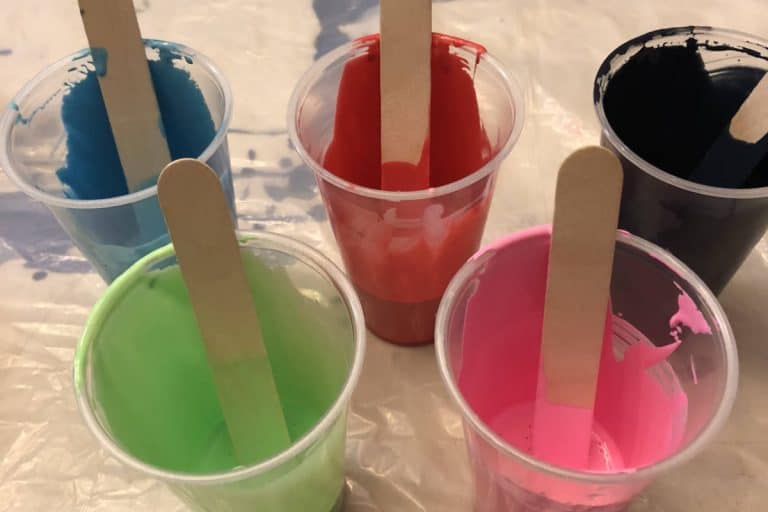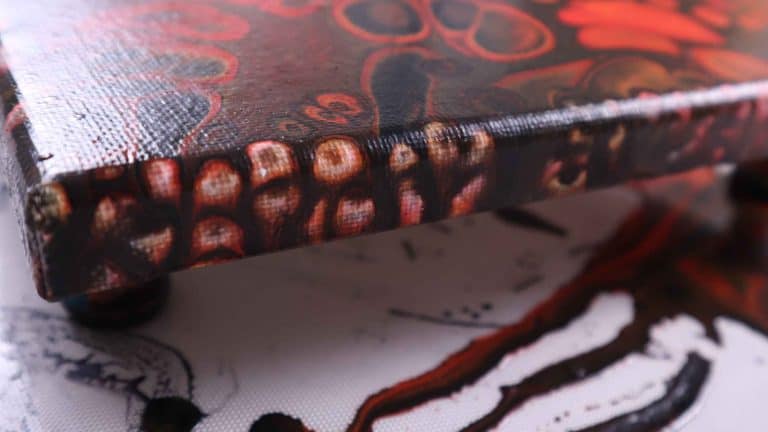Can Acrylic Paint Go Bad?
For a couple of years between high school and college I had a job doing commercial painting. I painted a lot of apartments; some of these apartments were painted with latex paint that was years old. Occasionally, we found these paints had gone bad. Let me tell you, when latex paint goes bad, it goes REALLY bad. Once I got into paint pouring, I wondered the same thing about acrylic paints.
Can acrylic paint go bad? Yes, acrylic paint can definitely go bad. Acrylic paint is susceptible to water related damage such as mold, mildew, and bacteria. In addition, acrylic paint can dry out or separate due to ambient environmental conditions.
Read on to find out some the common ways acrylic paints go bad, how to identify bad paint, and some tricks and tips for storing your acrylic paints to get the most life out of them.

How does Acrylic Paint Go Bad?
If you are anything like me, you probably have a stash of paints you’ve been hoarding for years. You remember those colors you used only once for a special project, or the stuff you got from friends and family because they didn’t use it anymore?
These paints tend to sit around until that moment when you realize you need that odd color, or that it’s time to clean out the old paints before they go bad.
After opening a handful of older paints, a few of them will invariably have gone bad. Some will be dried out, some will have started to separate, and some will be growing mini gardens of undesirables.
Here are a few of the common issues that cause acrylic paint to go bad.
Excessive Heat
As with any other liquid, ambient temperatures can have a significant effect on acrylic paint. As I mentioned in my post What is Acrylic Pour Painting, acrylic paints are made up of a number of different materials including pigment and a polymer emulsion. These materials are susceptible to extreme temperatures.
One of the main reasons acrylic paints were created was to get a paint that dries more quickly. When exposed to heat greater than the maximums recommended by the manufacture, the paint tends to dry out much more rapidly.
When acrylic paint loses too much of the water and other liquids that keep it pliable, it turns into a solid. This is especially problematic with acrylic paints because when dried and cured, these paints take on a plastic-like texture and become water resistant, which makes reusing them impossible.
Extreme Cold
Acrylic paints are viscous liquids that are an emulsion of multiple substances. An emulsion is where two liquids are forced to mix even though they tend to separate naturally. When exposed to cold temperatures for an extended period of time, the emulsions in acrylic paints have a tendency to separate.
This separation happens because the cold affects the contents of the acrylic paint differently. When a substance gets cold, the molecules inside the substance start to slow down. If molecules in one substance are moving around faster than in another substance, the quicker moving molecules can pull away from the slower ones.
The substance made of the faster moving molecules can become separated from the other substances over time, thus breaking up the emulsion of dissimilar liquids. In an acrylic, this looks like a clear liquid the separates from the color of the paint. The color pigment stays attached to the polymer/plastics (gelatinous colored material) and the solvents and water (clearer liquid) separate from the color.
In the case of extreme cold, the different liquids in the acrylic paint can freeze. Since every liquid freezes at a different rate, the materials that freeze first push out the other materials that don’t freeze as fast. This separation due to freezing is harder to see until the paint has had a chance to thaw.
Mold and Mildew
Mold and mildew are the bane of every homeowner. But did you know that acrylic paints can grow mold and mildew also? Mold and mildew are frequently associated with warm humid areas where foreign contaminates are present.
With paint, mold and mildew can grow when paint is exposed to unfiltered air or contaminated water. According the New York State Department of Health, mold can grown in numerous places inside a normal home including the kitchen, bathroom, closets, pipes, basements, crawlspaces, and more.
Mold produces spores which are spread through the air. These spores can live for 24 – 48 hours once detached from the mail mold body. These spores can also be contained in untreated water, including water from your faucet.
Even a single spore is capable of growing new mold.
Does Your Paint Have Mold?
The easiest way to tell if your paint has mold in it is by visual inspection. Mold will generally form on top the paint or withing the first 1/16″ as it needs access to light and air to grow.
Mildew and mold grow in a variety of colors including white, yellow, black, green, and brown. Mold looks like very fine hairs clumped together. Sometimes when the mold is under the surface of the paint it will look like a leaf or a clover lying on the paint surface.
Mold old tends to have a musty, rotten odor. If you open a container of paint and it smells bad, you could potentially have mold or mildew growing in your paint.
How to Prevent Mold and Mildew in Paint
Central air, swap coolers, open windows, and direct contact are the main ways that mold and mildew are spread. Since painting areas should be well ventilated, closing vents, doors and windows may not be the easiest solution.
Here are a few things you can do to prevent mold and mildew from growing in your paint.
- Keep paint in a sealed container when not being used
- Do not put any contaminates directly in the paint container. This includes water, additives not related to improving the life of paint, and textured materials. Always use a separate container for these mixture.
- Ensure that air is not flowing directly over the painting surface. This also affects the drying time of acrylic paints including paint pouring projects.
- Use an ozone generator or air purifier in the room where you paint. I recommend this one which you can get on Amazon.
- Keep the temperate of the room you are painting between 65 and 75 F.
- Keep paints open only as long as it takes to get the right amount out for the project.
- Make sure the paint lid seals by removing any dried paint on the end of the paint tube and the cap.
- Visually inspect the paint container to make sure there are no cracks or holes that will allow air and contaminates in.
For more information on how to store acrylic paints read our blog post here.
How to Revive Old Acrylic Paints
Acrylic paint that has dried or that has grown mold is probably not salvageable. You may be able to reclaim paint which has started to separate, or that has gotten clumpy.
First, determine if the clumps are dried paint, or if they are just the different materials in the paint clustering together. Dried paint will be hard while paint clusters will be squishy and when pressed will mix again with the paint.
If the paint is in a soft plastic container, try kneading the container slowly from one side to the other. For hard plastic or metal containers, use a wooden dowl, the backside of a paint brush, a paint knife, or a popsicle stick to slowly stir the paint back together. You might need to squish the clumps of paint against the side of the container to break them up.
Paints that have lost some of their moisture due to evaporation but that have not dried out completely might need some additional water or paint medium to help loosen their viscosity and mix. Use only distilled or purified water to ensure you are not adding additional pollutants into the paint.
If you are unsure if your paint is usable, disposal is probably your best option. Please consult your local City ordinances for proper paint disposal procedure.
Related Questions
How long does acrylic paint last once opened? Acrylic paint can last years after it has been opened. As long as the paint is not contaminated and it is stored in a place where it remains dry, undisturbed, and is not exposed to extreme temperatures, you should be able to use your acrylic paint for 5+ years. See the manufacturers recommendations for their acrylic paint shelf life.
How long does paint stay mixed after shaking? Most paints are designed to keep their mixture and consistency for long periods of time. Acrylic paint properly stored should not begin to separate weeks if not months. However, it is recommended to stir all acrylic paints before use to ensure that the acrylic polymers and pigment are evenly distributed for the best results during use.







Thanks for your insight🤓 it helps.
You are so welcome Pennie. Glad to be of service.
Your suggestions are so precious, everytime. Thank you soo much for spending your time to do a great job!
My pleasure Kareem. Glad they are helpful to you.
I’d love to know how to store your leftover pour paints. Do I keep them in the fridge or room temp? Love all your tips and tricks, helped me a bunch!
I just make sure they are in a sealed container. They will last for weeks like that assuming you used filtered or purified water.
I have a new gallon can of Sherwin Williams 100% acrylic paint that only opened once and only a few brush fulls of paint used out of it. It was accidentally left outside on the porch and I’m sure it froze. I opened the can today and the liquid on top was a yellowish or off white color but the bottom half of the can wasn’t rock hard and I was able to puncture it and lift it up so I could see it and the best way to describe it is that it looked like a paper air filter. Is this paint salvageable or irreversibly bad?
If with 5 minutes of mixing it isn’t smooth like cream then it isn’t salvagable. if it is smooth and has no gross smell (beyond acrylic paint smell) then it is probably still good.
My satin enamel leaves a white haze on the canvas. This is a new jar but was bought a couple of years ago. I mix it 50/50 with floetrol as a cloud mix but also mix it in Amsterdam titanium white. I work with fairly thick paint. Would appreciate your input. Many thanks.
Hmm, i’ve never hear of that happening with Satin enamel. You might try mixing it. Leaving it for 30 minutes. Mix it again and repeat 2 or 3 times. After the last time if there is any liquid on the top after it sits for a bit the paint is probably bad. It shouldn’t separate that fast.